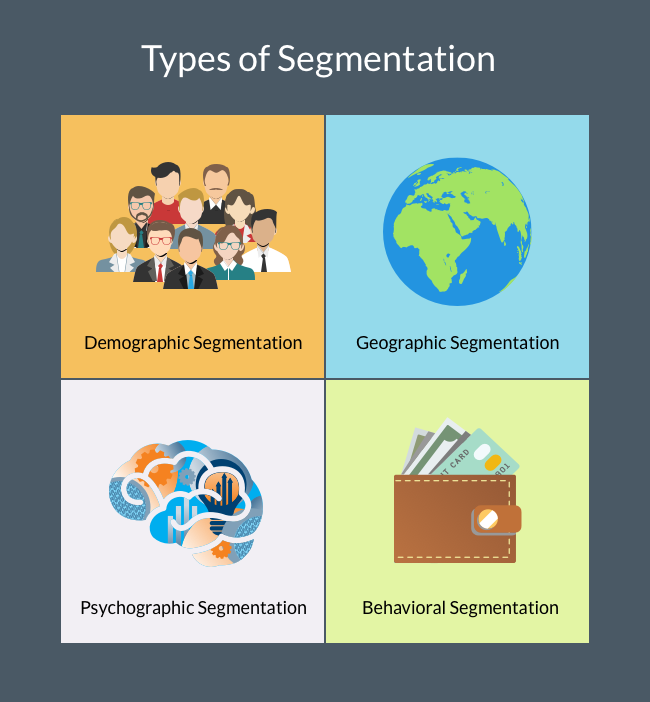Everyone in marketing is talking about the importance of learning as much as possible about people in terms of who they are as your potential customers. But what about learning more about your potential customers in terms of who they are as people? That’s where psychographic segmentation kicks in.
But before we go into more detail about the psychographic segmentation, let’s first briefly examine why it’s important to segment your market. In fact, it’s one of the crucial things to do if you want your business to be successful in the modern digital market. Here’s why.
The Importance of Segmentation in Marketing
I could probably sum up the importance of segmentation in marketing into one simple sentence – it is what enables you to sell more by selling to fewer.
What does market segmentation exactly mean? According to one definition, it is “the process of dividing a broad market, normally consisting of existing and potential customers, into subsets of consumers (known as segments), that exhibit some type of shared characteristics.”
 In other words, market segmentation presupposes dividing your potential customers into relevant groups, on the basis of a common denominator. That denominator is often some common interest or characteristic. For example, if you’re dealing with movie-related products or services, you could divide your target audience into fans of comedies, horrors, and thrillers.
In other words, market segmentation presupposes dividing your potential customers into relevant groups, on the basis of a common denominator. That denominator is often some common interest or characteristic. For example, if you’re dealing with movie-related products or services, you could divide your target audience into fans of comedies, horrors, and thrillers.
After you do so, it’s easy to target different segments of your market with custom ad campaigns. Such an approach to marketing certainly takes more time and effort but is definitely much more effective than the “one size fits all” approach.
Why is it important to segment? Well, segmenting your email lists into different groups, for example, has shown to increase open rates by 19% and click-through rates by 21%.
There are several different ways to segment your potential customers, but here are the 4 main ones (we’ll just briefly examine each and then go into more detail about the psychographic segmentation).
4 Main Types of Market Segmentation
The four most commonly used types of segmentation are shown in the image below. Each has found its application in different areas of marketing.

1. Demographic segmentation – Segment your market by personal attributes such as age, gender, ethnicity, marital status, household, education, or profession.
2. Geographic segmentation – Segment your market by country, region, state, or city.
3. Behavioral segmentation – Behavioral segmentation is the process of categorizing your potential and existing customers into smaller groups based on their purchasing behavior. It allows you to segment your market by how people use a product, their level of loyalty, or the benefits they are looking to get.
4. Psychographic segmentation – A bit more on this in the section below.
What is Psychographic Segmentation?
Psychographic segmentation is a market segmentation technique that enables you to categorize audiences and potential customers according to psychological traits that influence their buying habits. Those traits are drawn from an individual’s lifestyle and preferences.
While geographic and demographic market segmentation focus on quantifiable data, psychographic segmentation focuses on details that are not so easily measurable and are expressed in the form of different psychographic segmentation variables. Those variables are specific to each individual and are not so easily visible from the outside.

Unlike behavioral segmentation, the main purpose of which is to understand how to get your customers to make a decision to buy, psychographic segmentation aims at finding out how your brand fits your customers’ lives, in order to improve your marketing efforts.
Collecting psychographic data will give you an understanding of what your prospects hold high in life, issues they face, hesitations they might have when it comes to using your product/service, and how you can help them overcome those and find real value in what you offer.
5 Most Important Psychographic Segmentation Variables
The thing about psychographic segmentation variables is that they aren’t as quickly noticeable and as easily measured as other types of segmentation data (like demographic or geographical data).
This kind of information is not something you can know just by gathering basic data (using a simple survey or a questionnaire) or by looking at your customer. You need to go deeper and learn more about their psychological traits.
We’ll show you how to do this later on, but first, let’s examine 5 of the most common types of psychographic information (also known as the psychographic segmentation variables).
1. Lifestyle
What’s lifestyle anyway? In the simplest of terms, it’s how a person chooses to spend their time and money. It is a combination of all the activities, services, and goods they enjoy (and enjoy spending money on). Lifestyle is probably the most concrete and most useful piece of information you can obtain and use in the process of psychographic segmentation.

2. Personality
Do your customers have a great sense of humor? If so, it is likely they are going to appreciate your latest ad that revolves around a meme. If not, you might want to try with some more conventional advertising.
Are they analytical (focusing on numbers and concrete results) or do they prefer storytelling? Such insights can bring you a step closer to a perfect advertising copy, for example.
3. Attitudes and Values
This is a complex piece of psychographic data that encompasses everything from the way a person has been raised to different values acquired from exposure to certain life experiences. From a marketing perspective, those values are important because they’re likely to reflect one’s attitude towards a specific product, service, event, ad, and so on.
4. Activities, Interests, and Opinions (AIO)
Is your customer into competitive sports? Are they simply crazy about cars? Do they exercise regularly? Do they swear by Game of Thrones? Are they passionate gamers? And so on.

Knowing these kinds of things can be extremely important for your marketing efforts, even if you find out that your customers’ interests do not exactly match what you have to offer. That’s why you need to make sure to use the psychographic segmentation to segment your customers by their hobbies and interests.
5. Social Status
For marketers, social status is important only in terms of purchasing power. Let’s face it, if you’re trying to sell luxury vehicles, you’re unlikely to be targeting people from lower classes of society. Social status is directly related to the purchasing power, which is directly related to your marketing efforts in trying to reach and convince a potential customer to pay for your product or service.
How to Do Psychographic Segmentation
Wondering what’s the best, easiest, and most effective way to segment your market? Two words – online quizzes.
To do this, you’re going to need a high-quality lead generation tool. But what kind of a lead generator works best?
While good lead generation tools enable you to collect emails and other basic information about your customers, the best lead generation tools, allow you to learn more about your potential customers and divide them into different categories based on their demographic, geographic, behavioral and, most importantly to us here – psychographic information.
This leads us to online quizzes. Quizzes are an increasingly popular way to generate and segment leads. They are fun, engaging, and once you create them with a specific goal in your mind, they can gather all the data you need from your customers, without being intrusive or intimidating.
Rejuv Medical, a health clinic, used online quizzes to segment their potential patients and offer them exactly the services they need. The result? 15 new patients and $18,000 in revenue with only one quiz.
If you want to learn how to create your own quiz and use it to obtain valuable data about your potential customers, we’ve prepared this detailed quiz maker guide to help lead you through the entire process.
